Analysis of IAS-36 and Financial Instruments for Reckitt Benckiser PLC
VerifiedAdded on 2023/06/09
|15
|3320
|246
Report
AI Summary
This report provides an in-depth analysis of Reckitt Benckiser Group PLC's financial reporting practices, particularly focusing on the application of IAS-36 and its impact on asset valuation and impairment of goodwill. The report details the company's approach to determining cash-generating units, assessing cash flows, and recognizing impairment losses. It examines the assumptions underlying impairment tests, including discount rates, terminal growth rates, and revenue and EBIT growth projections. Furthermore, the report explores Reckitt's financial risk management strategies, including the handling of financial instruments, currency fluctuations, and interest rate risks. It also analyzes the company's defined benefit pension plan, including the calculation of obligations, discount rates, and alignment with industry practices. The analysis incorporates information from Reckitt's annual reports, financial statements, and relevant accounting standards to provide a comprehensive overview of the company's financial performance and risk management strategies.
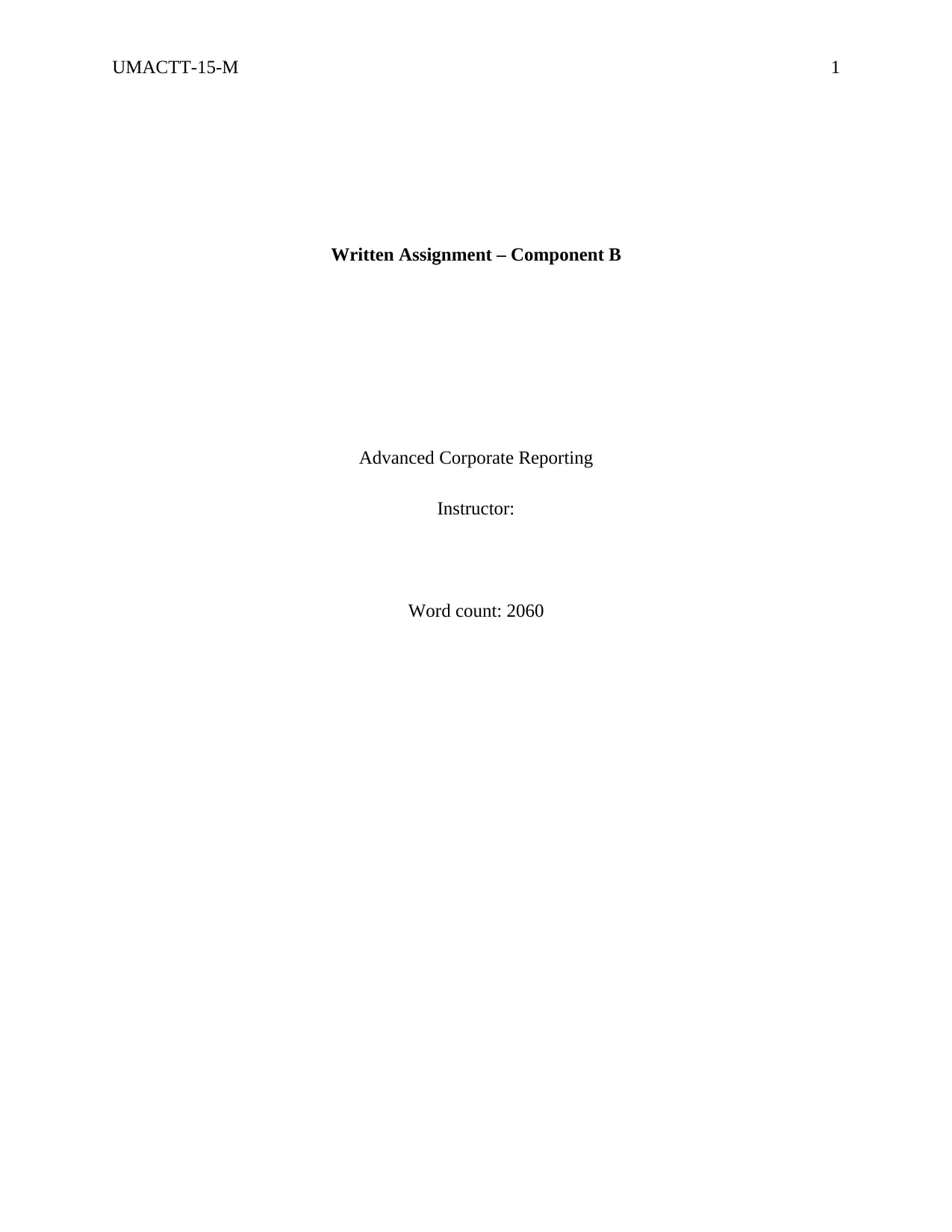
UMACTT-15-M 1
Written Assignment – Component B
Advanced Corporate Reporting
Instructor:
Word count: 2060
Written Assignment – Component B
Advanced Corporate Reporting
Instructor:
Word count: 2060
Paraphrase This Document
Need a fresh take? Get an instant paraphrase of this document with our AI Paraphraser

UMACTT-15-M 2
Executive Summary
Reckitt Benckiser Group PLC commonly known as Reckitt is a multinational consumer goods
corporation headquartered in England that produces nutrition, hygiene and health products. The
report has shed light on the application of IAS-36 by the “Reckitt Benckiser Group PLC” to
“value its assets” and “impairments of goodwill” in the firm. The firm has been reflecting,
“Impaired value of goodwill” to “985 million pounds” at the end of financial period of 2020.
The report also includes the information’s related to the financial instruments used by the
company. In the analysis report, the financial risk management analysis of Reckitt is mentioned
along with critical revelation of their benefits pension plans that are impaired with IAS 39 and
IFRS 9. These financial statements are impaired with the IASB conceptual framework that
reflects the qualitative characteristics.
Executive Summary
Reckitt Benckiser Group PLC commonly known as Reckitt is a multinational consumer goods
corporation headquartered in England that produces nutrition, hygiene and health products. The
report has shed light on the application of IAS-36 by the “Reckitt Benckiser Group PLC” to
“value its assets” and “impairments of goodwill” in the firm. The firm has been reflecting,
“Impaired value of goodwill” to “985 million pounds” at the end of financial period of 2020.
The report also includes the information’s related to the financial instruments used by the
company. In the analysis report, the financial risk management analysis of Reckitt is mentioned
along with critical revelation of their benefits pension plans that are impaired with IAS 39 and
IFRS 9. These financial statements are impaired with the IASB conceptual framework that
reflects the qualitative characteristics.
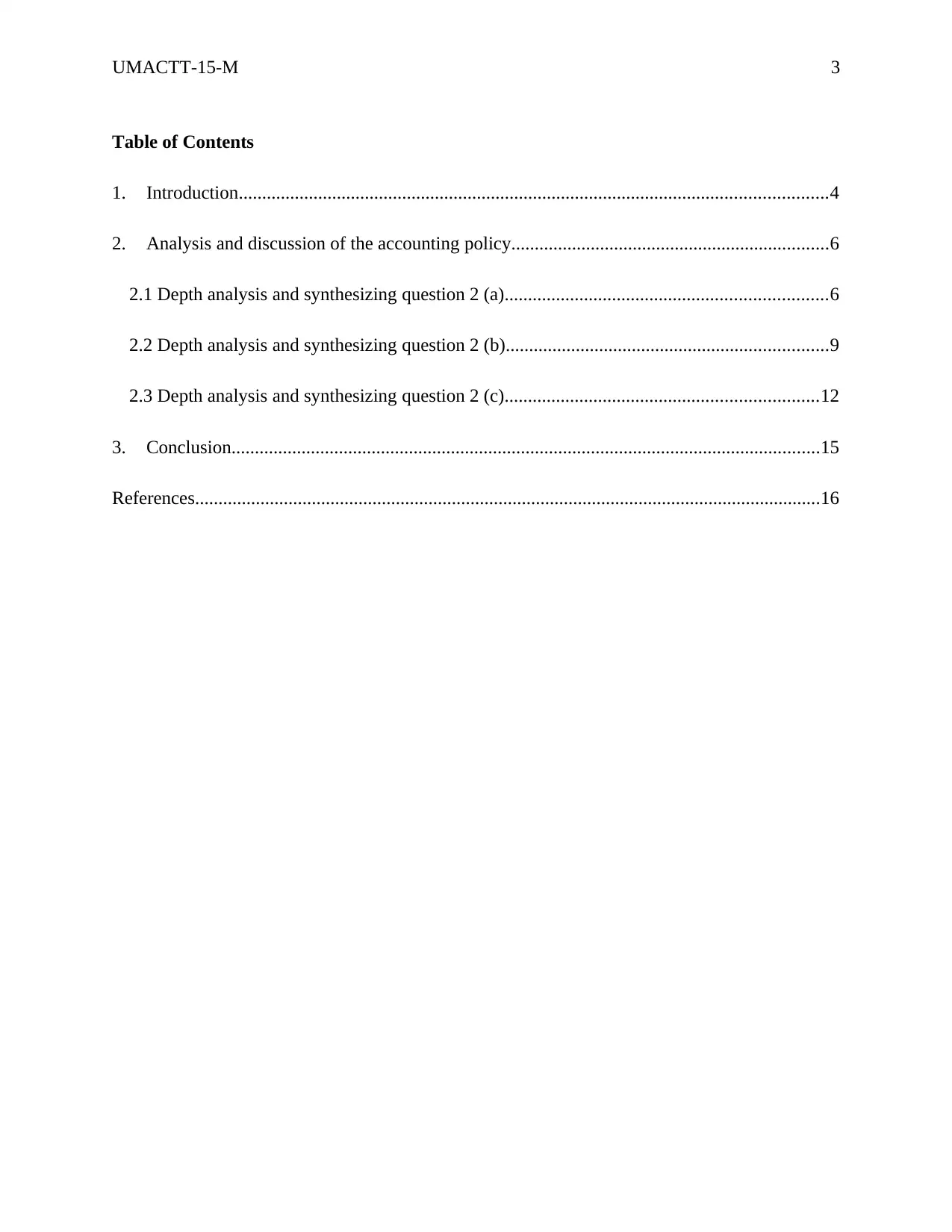
UMACTT-15-M 3
Table of Contents
1. Introduction..............................................................................................................................4
2. Analysis and discussion of the accounting policy....................................................................6
2.1 Depth analysis and synthesizing question 2 (a).....................................................................6
2.2 Depth analysis and synthesizing question 2 (b).....................................................................9
2.3 Depth analysis and synthesizing question 2 (c)...................................................................12
3. Conclusion..............................................................................................................................15
References......................................................................................................................................16
Table of Contents
1. Introduction..............................................................................................................................4
2. Analysis and discussion of the accounting policy....................................................................6
2.1 Depth analysis and synthesizing question 2 (a).....................................................................6
2.2 Depth analysis and synthesizing question 2 (b).....................................................................9
2.3 Depth analysis and synthesizing question 2 (c)...................................................................12
3. Conclusion..............................................................................................................................15
References......................................................................................................................................16
⊘ This is a preview!⊘
Do you want full access?
Subscribe today to unlock all pages.

Trusted by 1+ million students worldwide
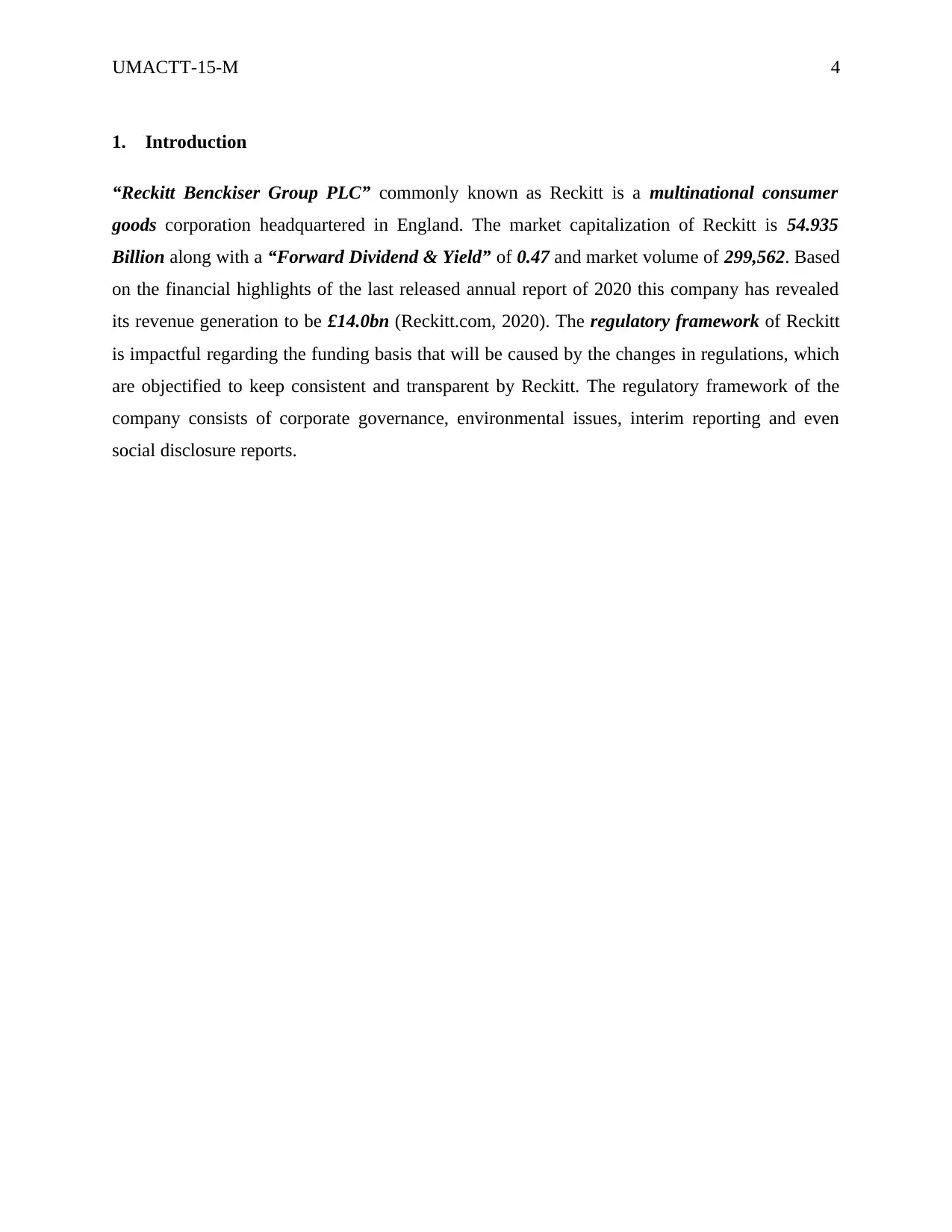
UMACTT-15-M 4
1. Introduction
“Reckitt Benckiser Group PLC” commonly known as Reckitt is a multinational consumer
goods corporation headquartered in England. The market capitalization of Reckitt is 54.935
Billion along with a “Forward Dividend & Yield” of 0.47 and market volume of 299,562. Based
on the financial highlights of the last released annual report of 2020 this company has revealed
its revenue generation to be £14.0bn (Reckitt.com, 2020). The regulatory framework of Reckitt
is impactful regarding the funding basis that will be caused by the changes in regulations, which
are objectified to keep consistent and transparent by Reckitt. The regulatory framework of the
company consists of corporate governance, environmental issues, interim reporting and even
social disclosure reports.
1. Introduction
“Reckitt Benckiser Group PLC” commonly known as Reckitt is a multinational consumer
goods corporation headquartered in England. The market capitalization of Reckitt is 54.935
Billion along with a “Forward Dividend & Yield” of 0.47 and market volume of 299,562. Based
on the financial highlights of the last released annual report of 2020 this company has revealed
its revenue generation to be £14.0bn (Reckitt.com, 2020). The regulatory framework of Reckitt
is impactful regarding the funding basis that will be caused by the changes in regulations, which
are objectified to keep consistent and transparent by Reckitt. The regulatory framework of the
company consists of corporate governance, environmental issues, interim reporting and even
social disclosure reports.
Paraphrase This Document
Need a fresh take? Get an instant paraphrase of this document with our AI Paraphraser

UMACTT-15-M 5
2. Analysis and discussion of the accounting policy
2.1 Depth analysis and synthesizing question 2 (a)
The “IAS-36” has reflected impairment of intangible assets while preceding the impairment test
of generating cash. The company has determined CGU on the basis of smallest identifiable group
of assets that are expected to generate cash inflows which are independent of other group of
assets. The assessment of cash flows for the purpose of impairment is done through cash flow
projections forming part of one-year budget or 3-5-year strategic plan and beyond that terminal
growth rates are used.
As per the financial report of the company, the value of “impairment of goodwill” has
been valued to “985 million pound” until 2020 (Reckitt, 2020). The basic requirement to
determine recoverable amount is dependent on the fair value of investment reduced by cost
incurred for selling it and applicable value of it. Based on the industrial practices the impairment
of goodwill is allocated as per the cash-generating units of the acquirer, which are expected to
get sheer benefits. As per IAS 36, the impairment loss is allocated to compensate the carrying
amount for the assets in the industry comparatively.
The impact of impairment test results was such where impairment of Goodwill lead to
reduction in the amount of capital employed which in turn enhances the ROCE used for LTIP
purposes. To ensure that the goodwill impairment doesn’t lead to increase in vesting with regards
to the proportion of LTIP associated with ROCE, the capital employed was then adjusted
accordingly. If the overly optimistic assumptions are being used for impairment assessment, then
it could result in no impairment charges recognition. After completing the impairment test,
Reckitt determined the value in use with respect to IFCN have high degree of estimation
uncertainty which could result in changing key assumptions and accordingly changes would take
place in IFCN valuation. A circumstance or event resulting from impairment test if indicates that
the carrying value is exceeding the recoverable amount of goodwill or intangible assets with
indefinite life, then the difference between the two is recognised in the income statement of the
company and accordingly, reduces the profitability of the concern.
2. Analysis and discussion of the accounting policy
2.1 Depth analysis and synthesizing question 2 (a)
The “IAS-36” has reflected impairment of intangible assets while preceding the impairment test
of generating cash. The company has determined CGU on the basis of smallest identifiable group
of assets that are expected to generate cash inflows which are independent of other group of
assets. The assessment of cash flows for the purpose of impairment is done through cash flow
projections forming part of one-year budget or 3-5-year strategic plan and beyond that terminal
growth rates are used.
As per the financial report of the company, the value of “impairment of goodwill” has
been valued to “985 million pound” until 2020 (Reckitt, 2020). The basic requirement to
determine recoverable amount is dependent on the fair value of investment reduced by cost
incurred for selling it and applicable value of it. Based on the industrial practices the impairment
of goodwill is allocated as per the cash-generating units of the acquirer, which are expected to
get sheer benefits. As per IAS 36, the impairment loss is allocated to compensate the carrying
amount for the assets in the industry comparatively.
The impact of impairment test results was such where impairment of Goodwill lead to
reduction in the amount of capital employed which in turn enhances the ROCE used for LTIP
purposes. To ensure that the goodwill impairment doesn’t lead to increase in vesting with regards
to the proportion of LTIP associated with ROCE, the capital employed was then adjusted
accordingly. If the overly optimistic assumptions are being used for impairment assessment, then
it could result in no impairment charges recognition. After completing the impairment test,
Reckitt determined the value in use with respect to IFCN have high degree of estimation
uncertainty which could result in changing key assumptions and accordingly changes would take
place in IFCN valuation. A circumstance or event resulting from impairment test if indicates that
the carrying value is exceeding the recoverable amount of goodwill or intangible assets with
indefinite life, then the difference between the two is recognised in the income statement of the
company and accordingly, reduces the profitability of the concern.

UMACTT-15-M 6
The assumptions underlying the impairment test meant for the impairment of goodwill &
intangible assets with indefinite life with respect to IFCN CGU of Reckitt involves the
following:
Pre - tax discount rate = 9.6% (Implied pre-tax discount rate & Weighted Average Cost of
Capital has been used to discount the projected cash flows).
Terminal growth rate = 2.5%
Annual growth in Net Revenue between 2021 & 2030 = 3 – 5% (resulting from premiumization,
revenue from new product and price increases)
Annual growth in Gross Margin between 2021 & 2030 = 3 – 6% (expected as a result of
operational leverage and benefits that would be derived from Reckitt’s ongoing productivity
programme).
The sensitivity is subject to reasonable changes in key assumptions.
Expected Net Revenue growth rates (2021 - 2030) adjusted by 100bps = +/- 900
Expected EBIT growth rates (2021 - 2030) adjusted by 100bps = +/- 600
Terminal growth rate (applicable from 2031) adjusted by 50bps = +600 / -500
Pre-tax discount rate adjusted by 50bps = +700 / -600
The company to calculate the “historical value of assets” in the firm has appropriately applied
the assumption of “reliability and going concern”. These assumptions have played a significant
role in forecasting the fluctuation in the future “value of assets” in the market. The company has
eagerly applied the sensitive analysis to recover the amount of the firm invested in the market.
The sensitivity analysis is considered as per the impairment charges based on previous
assumptions. The annual reports reflects on key facts as “Expected Net Revenue growth rates”
from 2021 to 2030 is +/- £900m. “Expected EBIT growth rates” from 2021 to 2031 is +/-
£600m (Reckitt.com, 2020).
The assumptions underlying the impairment test meant for the impairment of goodwill &
intangible assets with indefinite life with respect to IFCN CGU of Reckitt involves the
following:
Pre - tax discount rate = 9.6% (Implied pre-tax discount rate & Weighted Average Cost of
Capital has been used to discount the projected cash flows).
Terminal growth rate = 2.5%
Annual growth in Net Revenue between 2021 & 2030 = 3 – 5% (resulting from premiumization,
revenue from new product and price increases)
Annual growth in Gross Margin between 2021 & 2030 = 3 – 6% (expected as a result of
operational leverage and benefits that would be derived from Reckitt’s ongoing productivity
programme).
The sensitivity is subject to reasonable changes in key assumptions.
Expected Net Revenue growth rates (2021 - 2030) adjusted by 100bps = +/- 900
Expected EBIT growth rates (2021 - 2030) adjusted by 100bps = +/- 600
Terminal growth rate (applicable from 2031) adjusted by 50bps = +600 / -500
Pre-tax discount rate adjusted by 50bps = +700 / -600
The company to calculate the “historical value of assets” in the firm has appropriately applied
the assumption of “reliability and going concern”. These assumptions have played a significant
role in forecasting the fluctuation in the future “value of assets” in the market. The company has
eagerly applied the sensitive analysis to recover the amount of the firm invested in the market.
The sensitivity analysis is considered as per the impairment charges based on previous
assumptions. The annual reports reflects on key facts as “Expected Net Revenue growth rates”
from 2021 to 2030 is +/- £900m. “Expected EBIT growth rates” from 2021 to 2031 is +/-
£600m (Reckitt.com, 2020).
⊘ This is a preview!⊘
Do you want full access?
Subscribe today to unlock all pages.

Trusted by 1+ million students worldwide
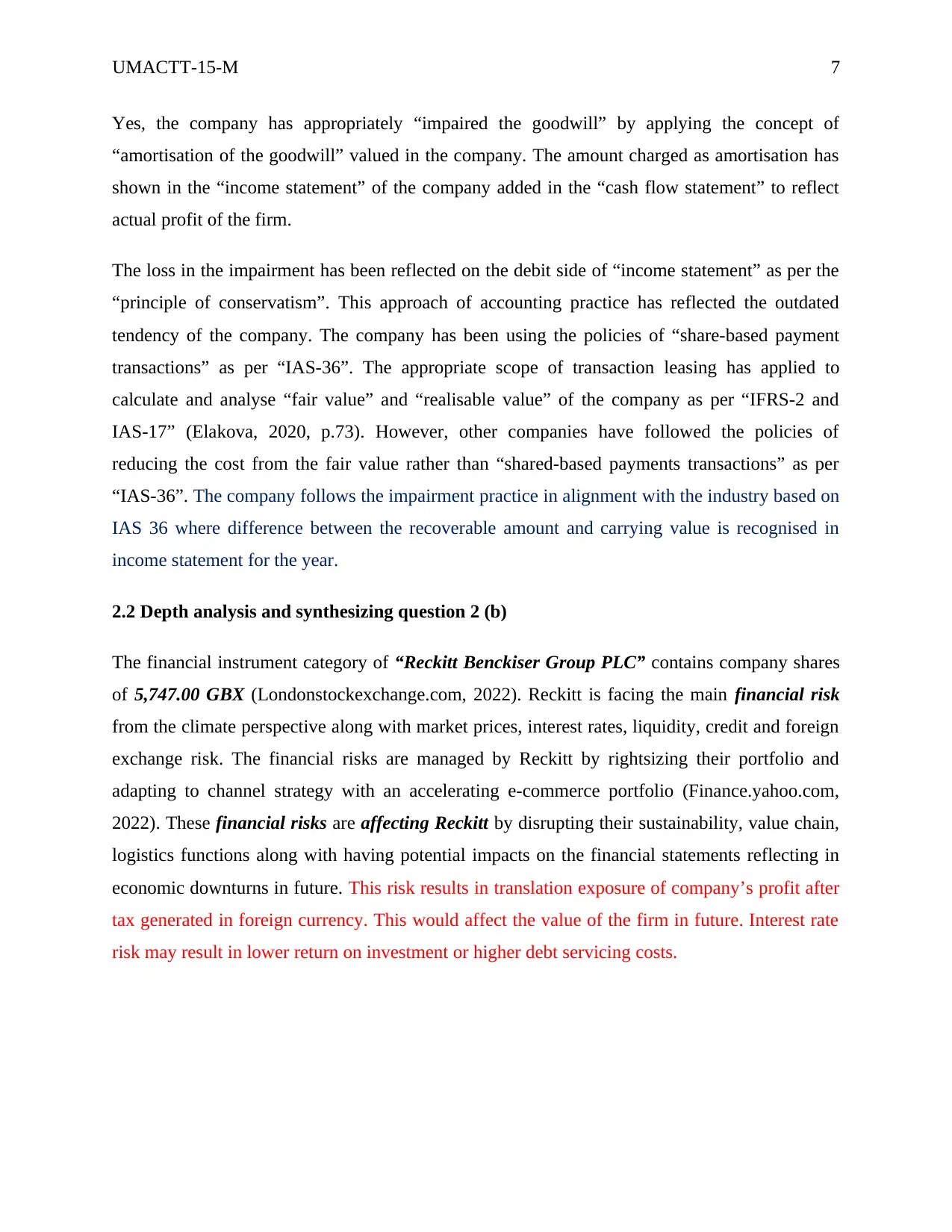
UMACTT-15-M 7
Yes, the company has appropriately “impaired the goodwill” by applying the concept of
“amortisation of the goodwill” valued in the company. The amount charged as amortisation has
shown in the “income statement” of the company added in the “cash flow statement” to reflect
actual profit of the firm.
The loss in the impairment has been reflected on the debit side of “income statement” as per the
“principle of conservatism”. This approach of accounting practice has reflected the outdated
tendency of the company. The company has been using the policies of “share-based payment
transactions” as per “IAS-36”. The appropriate scope of transaction leasing has applied to
calculate and analyse “fair value” and “realisable value” of the company as per “IFRS-2 and
IAS-17” (Elakova, 2020, p.73). However, other companies have followed the policies of
reducing the cost from the fair value rather than “shared-based payments transactions” as per
“IAS-36”. The company follows the impairment practice in alignment with the industry based on
IAS 36 where difference between the recoverable amount and carrying value is recognised in
income statement for the year.
2.2 Depth analysis and synthesizing question 2 (b)
The financial instrument category of “Reckitt Benckiser Group PLC” contains company shares
of 5,747.00 GBX (Londonstockexchange.com, 2022). Reckitt is facing the main financial risk
from the climate perspective along with market prices, interest rates, liquidity, credit and foreign
exchange risk. The financial risks are managed by Reckitt by rightsizing their portfolio and
adapting to channel strategy with an accelerating e-commerce portfolio (Finance.yahoo.com,
2022). These financial risks are affecting Reckitt by disrupting their sustainability, value chain,
logistics functions along with having potential impacts on the financial statements reflecting in
economic downturns in future. This risk results in translation exposure of company’s profit after
tax generated in foreign currency. This would affect the value of the firm in future. Interest rate
risk may result in lower return on investment or higher debt servicing costs.
Yes, the company has appropriately “impaired the goodwill” by applying the concept of
“amortisation of the goodwill” valued in the company. The amount charged as amortisation has
shown in the “income statement” of the company added in the “cash flow statement” to reflect
actual profit of the firm.
The loss in the impairment has been reflected on the debit side of “income statement” as per the
“principle of conservatism”. This approach of accounting practice has reflected the outdated
tendency of the company. The company has been using the policies of “share-based payment
transactions” as per “IAS-36”. The appropriate scope of transaction leasing has applied to
calculate and analyse “fair value” and “realisable value” of the company as per “IFRS-2 and
IAS-17” (Elakova, 2020, p.73). However, other companies have followed the policies of
reducing the cost from the fair value rather than “shared-based payments transactions” as per
“IAS-36”. The company follows the impairment practice in alignment with the industry based on
IAS 36 where difference between the recoverable amount and carrying value is recognised in
income statement for the year.
2.2 Depth analysis and synthesizing question 2 (b)
The financial instrument category of “Reckitt Benckiser Group PLC” contains company shares
of 5,747.00 GBX (Londonstockexchange.com, 2022). Reckitt is facing the main financial risk
from the climate perspective along with market prices, interest rates, liquidity, credit and foreign
exchange risk. The financial risks are managed by Reckitt by rightsizing their portfolio and
adapting to channel strategy with an accelerating e-commerce portfolio (Finance.yahoo.com,
2022). These financial risks are affecting Reckitt by disrupting their sustainability, value chain,
logistics functions along with having potential impacts on the financial statements reflecting in
economic downturns in future. This risk results in translation exposure of company’s profit after
tax generated in foreign currency. This would affect the value of the firm in future. Interest rate
risk may result in lower return on investment or higher debt servicing costs.
Paraphrase This Document
Need a fresh take? Get an instant paraphrase of this document with our AI Paraphraser
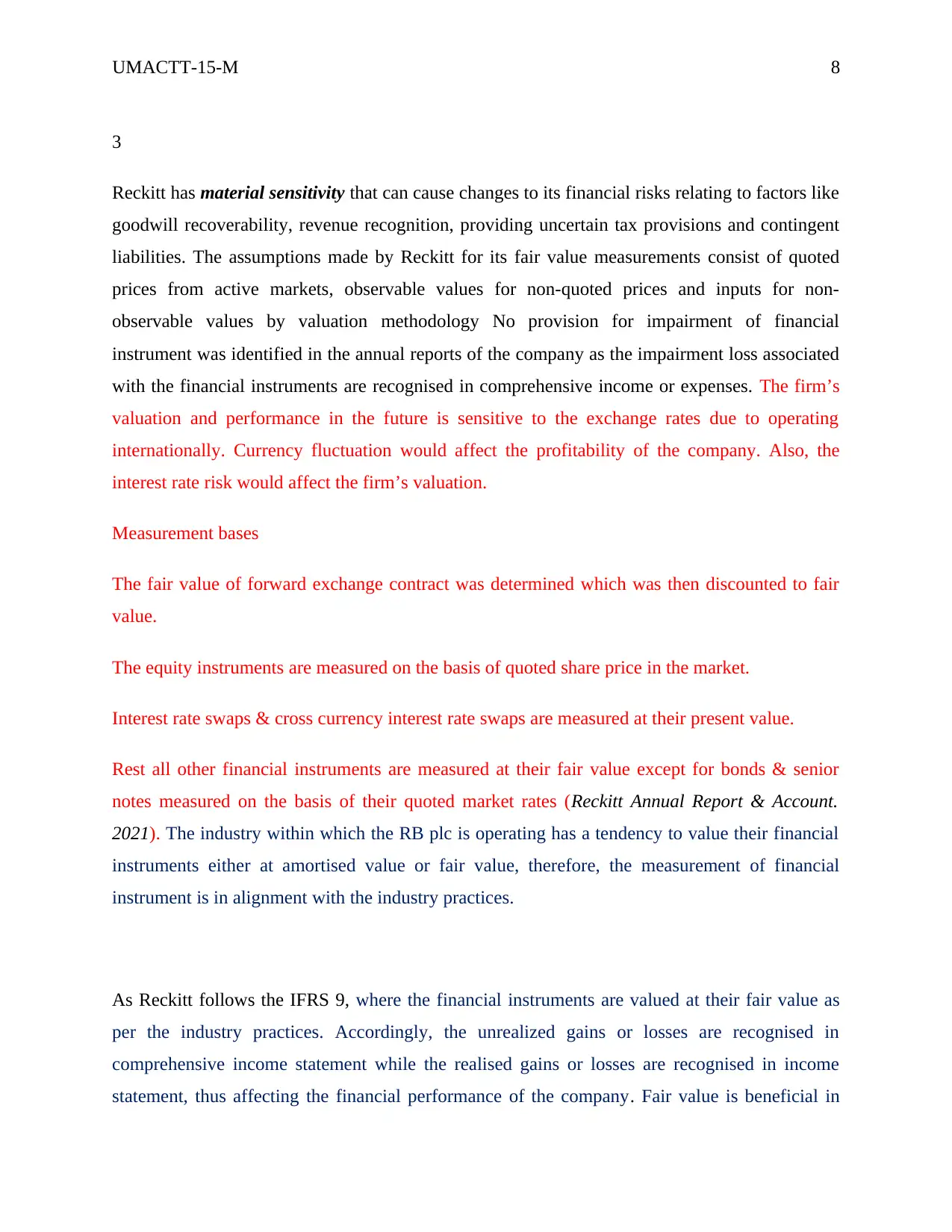
UMACTT-15-M 8
3
Reckitt has material sensitivity that can cause changes to its financial risks relating to factors like
goodwill recoverability, revenue recognition, providing uncertain tax provisions and contingent
liabilities. The assumptions made by Reckitt for its fair value measurements consist of quoted
prices from active markets, observable values for non-quoted prices and inputs for non-
observable values by valuation methodology No provision for impairment of financial
instrument was identified in the annual reports of the company as the impairment loss associated
with the financial instruments are recognised in comprehensive income or expenses. The firm’s
valuation and performance in the future is sensitive to the exchange rates due to operating
internationally. Currency fluctuation would affect the profitability of the company. Also, the
interest rate risk would affect the firm’s valuation.
Measurement bases
The fair value of forward exchange contract was determined which was then discounted to fair
value.
The equity instruments are measured on the basis of quoted share price in the market.
Interest rate swaps & cross currency interest rate swaps are measured at their present value.
Rest all other financial instruments are measured at their fair value except for bonds & senior
notes measured on the basis of their quoted market rates (Reckitt Annual Report & Account.
2021). The industry within which the RB plc is operating has a tendency to value their financial
instruments either at amortised value or fair value, therefore, the measurement of financial
instrument is in alignment with the industry practices.
As Reckitt follows the IFRS 9, where the financial instruments are valued at their fair value as
per the industry practices. Accordingly, the unrealized gains or losses are recognised in
comprehensive income statement while the realised gains or losses are recognised in income
statement, thus affecting the financial performance of the company. Fair value is beneficial in
3
Reckitt has material sensitivity that can cause changes to its financial risks relating to factors like
goodwill recoverability, revenue recognition, providing uncertain tax provisions and contingent
liabilities. The assumptions made by Reckitt for its fair value measurements consist of quoted
prices from active markets, observable values for non-quoted prices and inputs for non-
observable values by valuation methodology No provision for impairment of financial
instrument was identified in the annual reports of the company as the impairment loss associated
with the financial instruments are recognised in comprehensive income or expenses. The firm’s
valuation and performance in the future is sensitive to the exchange rates due to operating
internationally. Currency fluctuation would affect the profitability of the company. Also, the
interest rate risk would affect the firm’s valuation.
Measurement bases
The fair value of forward exchange contract was determined which was then discounted to fair
value.
The equity instruments are measured on the basis of quoted share price in the market.
Interest rate swaps & cross currency interest rate swaps are measured at their present value.
Rest all other financial instruments are measured at their fair value except for bonds & senior
notes measured on the basis of their quoted market rates (Reckitt Annual Report & Account.
2021). The industry within which the RB plc is operating has a tendency to value their financial
instruments either at amortised value or fair value, therefore, the measurement of financial
instrument is in alignment with the industry practices.
As Reckitt follows the IFRS 9, where the financial instruments are valued at their fair value as
per the industry practices. Accordingly, the unrealized gains or losses are recognised in
comprehensive income statement while the realised gains or losses are recognised in income
statement, thus affecting the financial performance of the company. Fair value is beneficial in
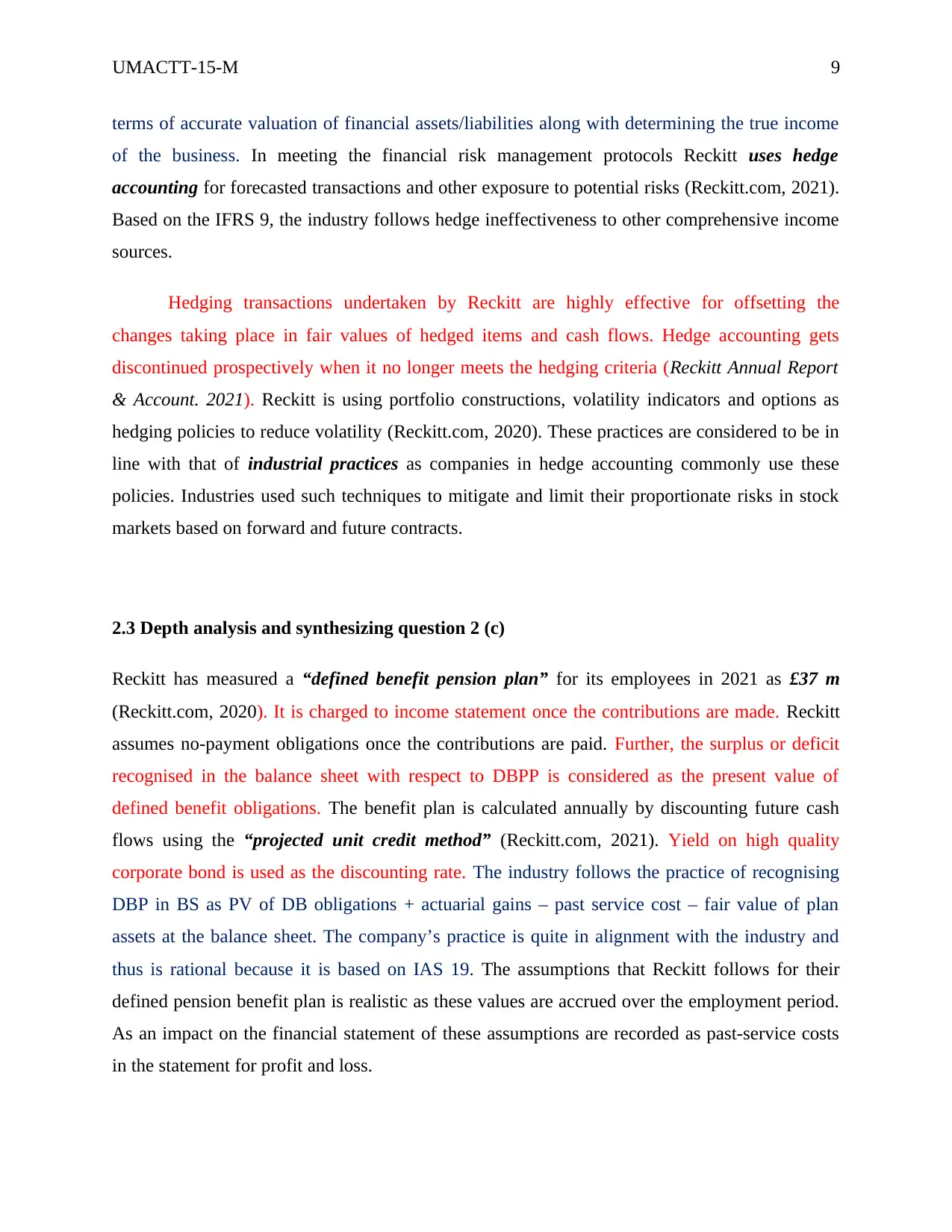
UMACTT-15-M 9
terms of accurate valuation of financial assets/liabilities along with determining the true income
of the business. In meeting the financial risk management protocols Reckitt uses hedge
accounting for forecasted transactions and other exposure to potential risks (Reckitt.com, 2021).
Based on the IFRS 9, the industry follows hedge ineffectiveness to other comprehensive income
sources.
Hedging transactions undertaken by Reckitt are highly effective for offsetting the
changes taking place in fair values of hedged items and cash flows. Hedge accounting gets
discontinued prospectively when it no longer meets the hedging criteria (Reckitt Annual Report
& Account. 2021). Reckitt is using portfolio constructions, volatility indicators and options as
hedging policies to reduce volatility (Reckitt.com, 2020). These practices are considered to be in
line with that of industrial practices as companies in hedge accounting commonly use these
policies. Industries used such techniques to mitigate and limit their proportionate risks in stock
markets based on forward and future contracts.
2.3 Depth analysis and synthesizing question 2 (c)
Reckitt has measured a “defined benefit pension plan” for its employees in 2021 as £37 m
(Reckitt.com, 2020). It is charged to income statement once the contributions are made. Reckitt
assumes no-payment obligations once the contributions are paid. Further, the surplus or deficit
recognised in the balance sheet with respect to DBPP is considered as the present value of
defined benefit obligations. The benefit plan is calculated annually by discounting future cash
flows using the “projected unit credit method” (Reckitt.com, 2021). Yield on high quality
corporate bond is used as the discounting rate. The industry follows the practice of recognising
DBP in BS as PV of DB obligations + actuarial gains – past service cost – fair value of plan
assets at the balance sheet. The company’s practice is quite in alignment with the industry and
thus is rational because it is based on IAS 19. The assumptions that Reckitt follows for their
defined pension benefit plan is realistic as these values are accrued over the employment period.
As an impact on the financial statement of these assumptions are recorded as past-service costs
in the statement for profit and loss.
terms of accurate valuation of financial assets/liabilities along with determining the true income
of the business. In meeting the financial risk management protocols Reckitt uses hedge
accounting for forecasted transactions and other exposure to potential risks (Reckitt.com, 2021).
Based on the IFRS 9, the industry follows hedge ineffectiveness to other comprehensive income
sources.
Hedging transactions undertaken by Reckitt are highly effective for offsetting the
changes taking place in fair values of hedged items and cash flows. Hedge accounting gets
discontinued prospectively when it no longer meets the hedging criteria (Reckitt Annual Report
& Account. 2021). Reckitt is using portfolio constructions, volatility indicators and options as
hedging policies to reduce volatility (Reckitt.com, 2020). These practices are considered to be in
line with that of industrial practices as companies in hedge accounting commonly use these
policies. Industries used such techniques to mitigate and limit their proportionate risks in stock
markets based on forward and future contracts.
2.3 Depth analysis and synthesizing question 2 (c)
Reckitt has measured a “defined benefit pension plan” for its employees in 2021 as £37 m
(Reckitt.com, 2020). It is charged to income statement once the contributions are made. Reckitt
assumes no-payment obligations once the contributions are paid. Further, the surplus or deficit
recognised in the balance sheet with respect to DBPP is considered as the present value of
defined benefit obligations. The benefit plan is calculated annually by discounting future cash
flows using the “projected unit credit method” (Reckitt.com, 2021). Yield on high quality
corporate bond is used as the discounting rate. The industry follows the practice of recognising
DBP in BS as PV of DB obligations + actuarial gains – past service cost – fair value of plan
assets at the balance sheet. The company’s practice is quite in alignment with the industry and
thus is rational because it is based on IAS 19. The assumptions that Reckitt follows for their
defined pension benefit plan is realistic as these values are accrued over the employment period.
As an impact on the financial statement of these assumptions are recorded as past-service costs
in the statement for profit and loss.
⊘ This is a preview!⊘
Do you want full access?
Subscribe today to unlock all pages.

Trusted by 1+ million students worldwide
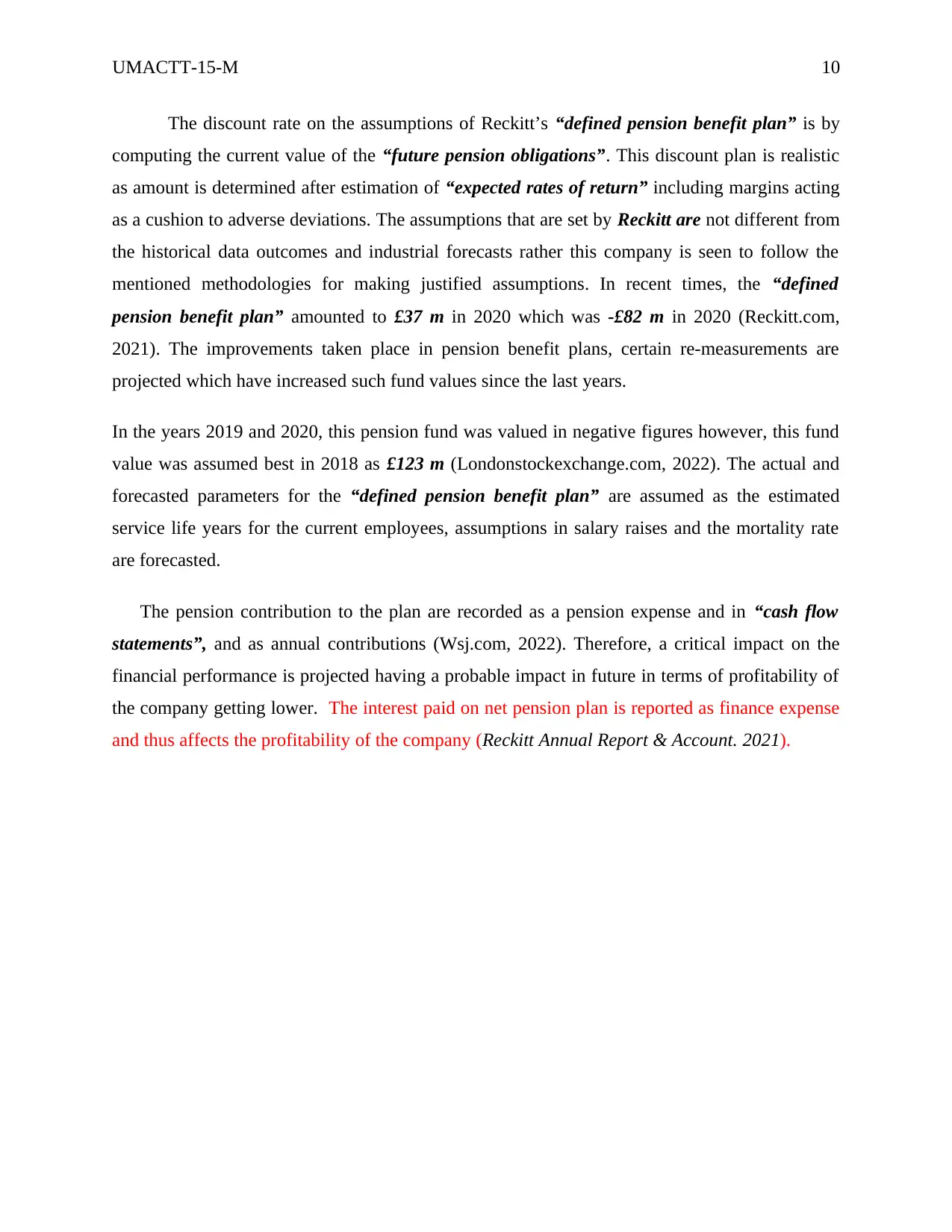
UMACTT-15-M 10
The discount rate on the assumptions of Reckitt’s “defined pension benefit plan” is by
computing the current value of the “future pension obligations”. This discount plan is realistic
as amount is determined after estimation of “expected rates of return” including margins acting
as a cushion to adverse deviations. The assumptions that are set by Reckitt are not different from
the historical data outcomes and industrial forecasts rather this company is seen to follow the
mentioned methodologies for making justified assumptions. In recent times, the “defined
pension benefit plan” amounted to £37 m in 2020 which was -£82 m in 2020 (Reckitt.com,
2021). The improvements taken place in pension benefit plans, certain re-measurements are
projected which have increased such fund values since the last years.
In the years 2019 and 2020, this pension fund was valued in negative figures however, this fund
value was assumed best in 2018 as £123 m (Londonstockexchange.com, 2022). The actual and
forecasted parameters for the “defined pension benefit plan” are assumed as the estimated
service life years for the current employees, assumptions in salary raises and the mortality rate
are forecasted.
The pension contribution to the plan are recorded as a pension expense and in “cash flow
statements”, and as annual contributions (Wsj.com, 2022). Therefore, a critical impact on the
financial performance is projected having a probable impact in future in terms of profitability of
the company getting lower. The interest paid on net pension plan is reported as finance expense
and thus affects the profitability of the company (Reckitt Annual Report & Account. 2021).
The discount rate on the assumptions of Reckitt’s “defined pension benefit plan” is by
computing the current value of the “future pension obligations”. This discount plan is realistic
as amount is determined after estimation of “expected rates of return” including margins acting
as a cushion to adverse deviations. The assumptions that are set by Reckitt are not different from
the historical data outcomes and industrial forecasts rather this company is seen to follow the
mentioned methodologies for making justified assumptions. In recent times, the “defined
pension benefit plan” amounted to £37 m in 2020 which was -£82 m in 2020 (Reckitt.com,
2021). The improvements taken place in pension benefit plans, certain re-measurements are
projected which have increased such fund values since the last years.
In the years 2019 and 2020, this pension fund was valued in negative figures however, this fund
value was assumed best in 2018 as £123 m (Londonstockexchange.com, 2022). The actual and
forecasted parameters for the “defined pension benefit plan” are assumed as the estimated
service life years for the current employees, assumptions in salary raises and the mortality rate
are forecasted.
The pension contribution to the plan are recorded as a pension expense and in “cash flow
statements”, and as annual contributions (Wsj.com, 2022). Therefore, a critical impact on the
financial performance is projected having a probable impact in future in terms of profitability of
the company getting lower. The interest paid on net pension plan is reported as finance expense
and thus affects the profitability of the company (Reckitt Annual Report & Account. 2021).
Paraphrase This Document
Need a fresh take? Get an instant paraphrase of this document with our AI Paraphraser
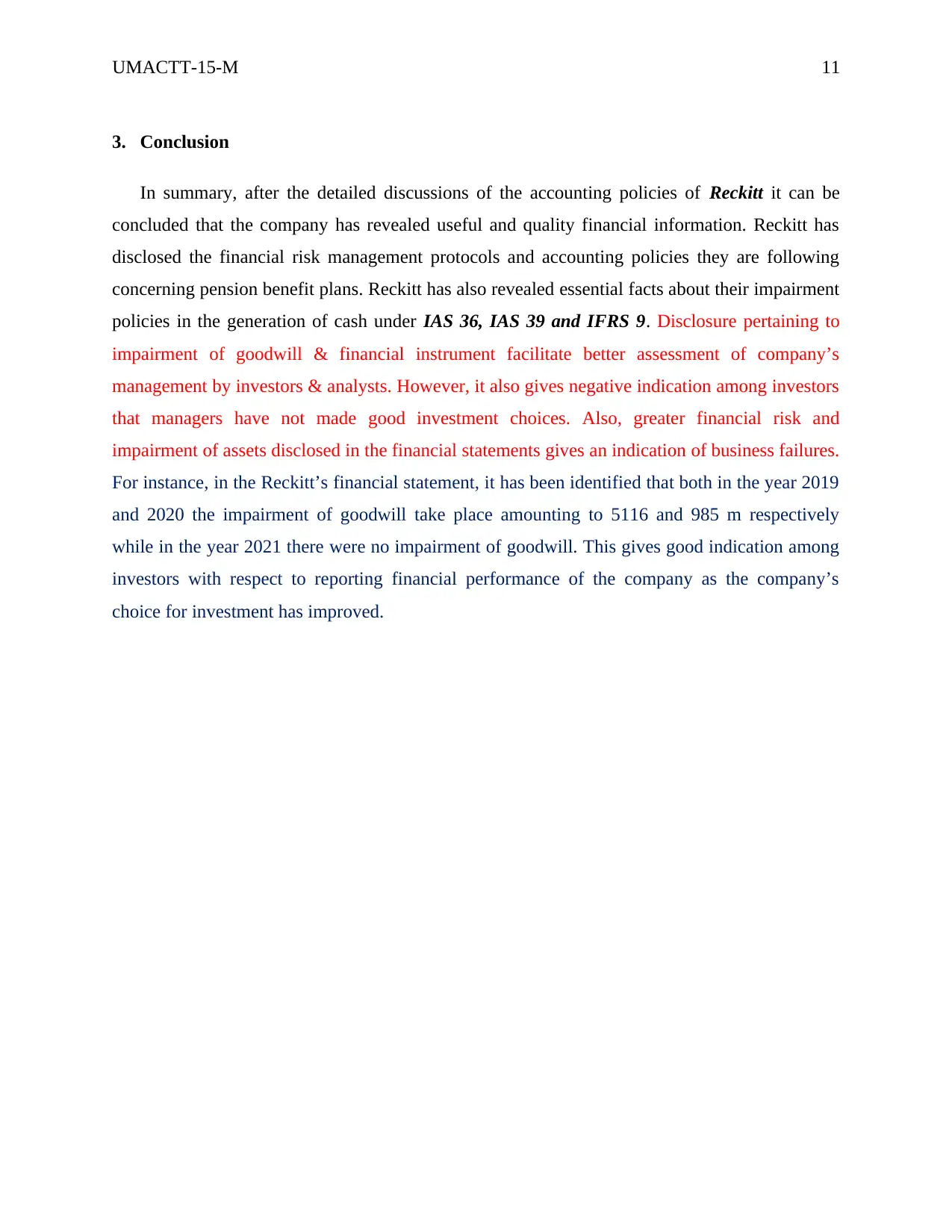
UMACTT-15-M 11
3. Conclusion
In summary, after the detailed discussions of the accounting policies of Reckitt it can be
concluded that the company has revealed useful and quality financial information. Reckitt has
disclosed the financial risk management protocols and accounting policies they are following
concerning pension benefit plans. Reckitt has also revealed essential facts about their impairment
policies in the generation of cash under IAS 36, IAS 39 and IFRS 9. Disclosure pertaining to
impairment of goodwill & financial instrument facilitate better assessment of company’s
management by investors & analysts. However, it also gives negative indication among investors
that managers have not made good investment choices. Also, greater financial risk and
impairment of assets disclosed in the financial statements gives an indication of business failures.
For instance, in the Reckitt’s financial statement, it has been identified that both in the year 2019
and 2020 the impairment of goodwill take place amounting to 5116 and 985 m respectively
while in the year 2021 there were no impairment of goodwill. This gives good indication among
investors with respect to reporting financial performance of the company as the company’s
choice for investment has improved.
3. Conclusion
In summary, after the detailed discussions of the accounting policies of Reckitt it can be
concluded that the company has revealed useful and quality financial information. Reckitt has
disclosed the financial risk management protocols and accounting policies they are following
concerning pension benefit plans. Reckitt has also revealed essential facts about their impairment
policies in the generation of cash under IAS 36, IAS 39 and IFRS 9. Disclosure pertaining to
impairment of goodwill & financial instrument facilitate better assessment of company’s
management by investors & analysts. However, it also gives negative indication among investors
that managers have not made good investment choices. Also, greater financial risk and
impairment of assets disclosed in the financial statements gives an indication of business failures.
For instance, in the Reckitt’s financial statement, it has been identified that both in the year 2019
and 2020 the impairment of goodwill take place amounting to 5116 and 985 m respectively
while in the year 2021 there were no impairment of goodwill. This gives good indication among
investors with respect to reporting financial performance of the company as the company’s
choice for investment has improved.
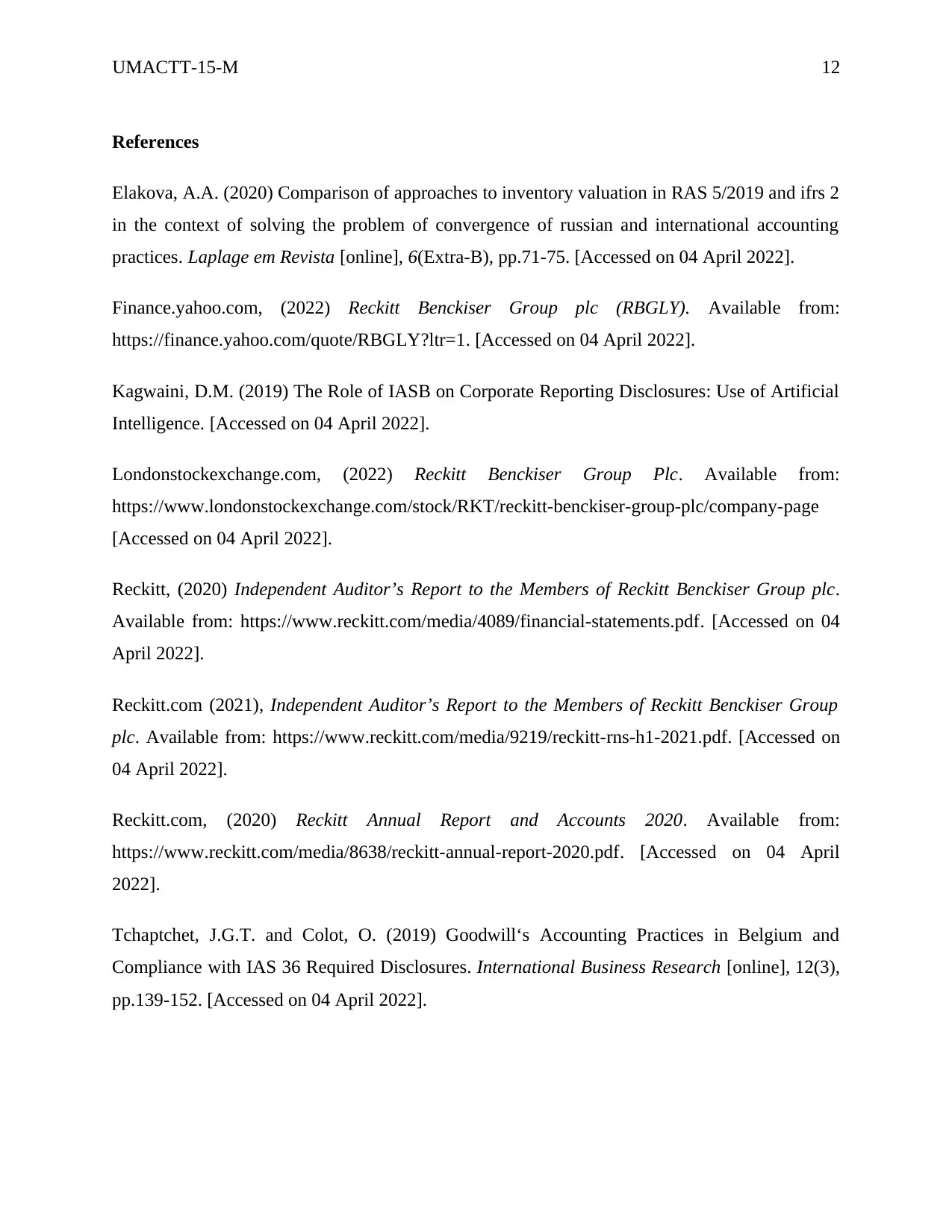
UMACTT-15-M 12
References
Elakova, A.A. (2020) Comparison of approaches to inventory valuation in RAS 5/2019 and ifrs 2
in the context of solving the problem of convergence of russian and international accounting
practices. Laplage em Revista [online], 6(Extra-B), pp.71-75. [Accessed on 04 April 2022].
Finance.yahoo.com, (2022) Reckitt Benckiser Group plc (RBGLY). Available from:
https://finance.yahoo.com/quote/RBGLY?ltr=1. [Accessed on 04 April 2022].
Kagwaini, D.M. (2019) The Role of IASB on Corporate Reporting Disclosures: Use of Artificial
Intelligence. [Accessed on 04 April 2022].
Londonstockexchange.com, (2022) Reckitt Benckiser Group Plc. Available from:
https://www.londonstockexchange.com/stock/RKT/reckitt-benckiser-group-plc/company-page
[Accessed on 04 April 2022].
Reckitt, (2020) Independent Auditor’s Report to the Members of Reckitt Benckiser Group plc.
Available from: https://www.reckitt.com/media/4089/financial-statements.pdf. [Accessed on 04
April 2022].
Reckitt.com (2021), Independent Auditor’s Report to the Members of Reckitt Benckiser Group
plc. Available from: https://www.reckitt.com/media/9219/reckitt-rns-h1-2021.pdf. [Accessed on
04 April 2022].
Reckitt.com, (2020) Reckitt Annual Report and Accounts 2020. Available from:
https://www.reckitt.com/media/8638/reckitt-annual-report-2020.pdf. [Accessed on 04 April
2022].
Tchaptchet, J.G.T. and Colot, O. (2019) Goodwill‘s Accounting Practices in Belgium and
Compliance with IAS 36 Required Disclosures. International Business Research [online], 12(3),
pp.139-152. [Accessed on 04 April 2022].
References
Elakova, A.A. (2020) Comparison of approaches to inventory valuation in RAS 5/2019 and ifrs 2
in the context of solving the problem of convergence of russian and international accounting
practices. Laplage em Revista [online], 6(Extra-B), pp.71-75. [Accessed on 04 April 2022].
Finance.yahoo.com, (2022) Reckitt Benckiser Group plc (RBGLY). Available from:
https://finance.yahoo.com/quote/RBGLY?ltr=1. [Accessed on 04 April 2022].
Kagwaini, D.M. (2019) The Role of IASB on Corporate Reporting Disclosures: Use of Artificial
Intelligence. [Accessed on 04 April 2022].
Londonstockexchange.com, (2022) Reckitt Benckiser Group Plc. Available from:
https://www.londonstockexchange.com/stock/RKT/reckitt-benckiser-group-plc/company-page
[Accessed on 04 April 2022].
Reckitt, (2020) Independent Auditor’s Report to the Members of Reckitt Benckiser Group plc.
Available from: https://www.reckitt.com/media/4089/financial-statements.pdf. [Accessed on 04
April 2022].
Reckitt.com (2021), Independent Auditor’s Report to the Members of Reckitt Benckiser Group
plc. Available from: https://www.reckitt.com/media/9219/reckitt-rns-h1-2021.pdf. [Accessed on
04 April 2022].
Reckitt.com, (2020) Reckitt Annual Report and Accounts 2020. Available from:
https://www.reckitt.com/media/8638/reckitt-annual-report-2020.pdf. [Accessed on 04 April
2022].
Tchaptchet, J.G.T. and Colot, O. (2019) Goodwill‘s Accounting Practices in Belgium and
Compliance with IAS 36 Required Disclosures. International Business Research [online], 12(3),
pp.139-152. [Accessed on 04 April 2022].
⊘ This is a preview!⊘
Do you want full access?
Subscribe today to unlock all pages.

Trusted by 1+ million students worldwide
1 out of 15